
Heliconia is a genus of flowering plants in the monotypic family Heliconiaceae. Most of the 194 known species are native to the tropical Americas, but a few are indigenous to certain islands of the western Pacific and Maluku in Indonesia. Many species of Heliconia are found in the tropical forests of these regions. Most species are listed as either vulnerable or data deficient by the IUCN Red List of threatened species. Several species are widely cultivated as ornamentals, and a few are naturalized in Florida, Gambia, and Thailand.

The cardoon, also called the artichoke thistle, is a thistle in the family Asteraceae. It is a naturally occurring species that also has many cultivated forms, including the globe artichoke. It is native to the western and central Mediterranean region, where it was domesticated in ancient times and still occurs as a wild plant.

Myrciaria floribunda, commonly known as cambuizeiro, guavaberry or rumberry, is a species of plant in the family Myrtaceae. It can be found across South and Central America and the West Indies in dry or moist coastal woodlands, up to 300 metres above sea level. The guavaberry, which should not be confused with the guava, is a close relative of camu camu.
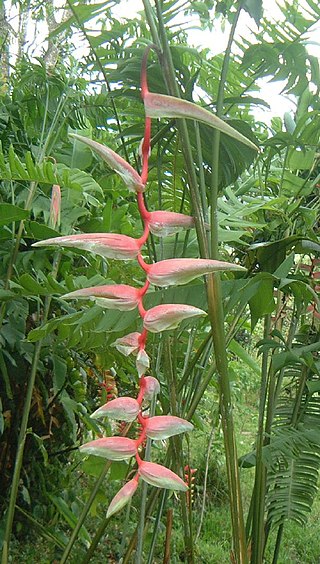
Heliconia chartacea is a species of Heliconia native to tropical South America.

Heliconia bihai of the family Heliconiaceae is an erect herb typically growing taller than 1.5 m. It is native to northern South America and the West Indies. It is especially common in northern Brazil and the Guianas but also found in Hispaniola, Jamaica, the Lesser Antilles, Puerto Rico, Trinidad, Venezuela and Colombia. Other names by which the plant is commonly known include balisier and macawflower.
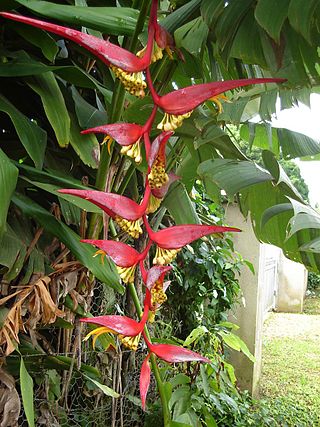
Heliconia collinsiana (platanillo) of family Heliconiaceae is an erect herb typically growing 10–15 feet (3.0–4.6 m) tall, native to Guatemala, Honduras, El Salvador, Nicaragua and southern Mexico.
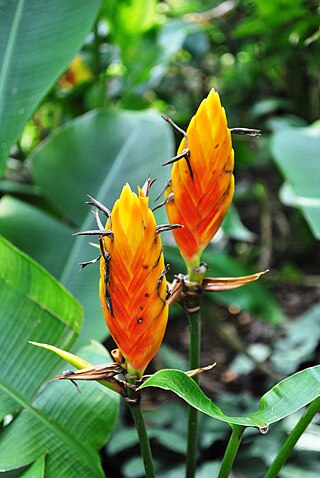
Heliconia episcopalis is a species of plant in the family Heliconiaceae. It is an erect herb typically grows up to 2 meters tall, native to the Amazon Rainforest, in Colombia, Venezuela, Guyana, French Guiana, Suriname, Brazil, Ecuador, and Peru in South America.

Heliconia hirsuta is a species of flowering plant in the family Heliconiaceae. This plant is an erect herb up to 2 m tall, and it is native to Central America, South America, and the Caribbean, from Belize to Trinidad to Argentina.
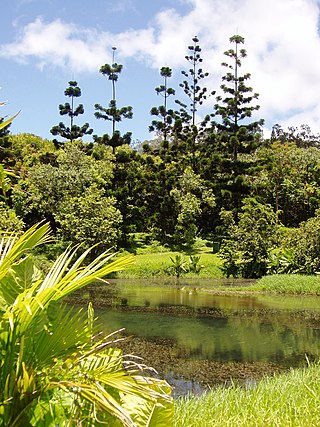
The Hoʻomaluhia Botanical Garden is a botanical garden located at 45–680 Luluku Road, Kāne'ohe, Oahu, Hawaii. It is part of the Honolulu Botanical Gardens, and is open daily, without charge, except for Christmas Day and New Year's Day.

Heliconia rostrata, the hanging lobster claw or false bird of paradise, is a herbaceous perennial plant native to El Salvador, Peru, Bolivia, Colombia, Venezuela, Costa Rica, and Ecuador, and naturalized in Puerto Rico. Other heliconias grow in an upright position, their cup-shaped flower bracts storing water for birds and insects. This plant, however, has downward-facing flowers, the flowers thus providing a source of nectar to birds.

Ruellia brevifolia, the tropical wild petunia or red Christmas pride, is an ornamental plant in the family Acanthaceae. It is native to South America, from Colombia to southern Brazil and northern Argentina.
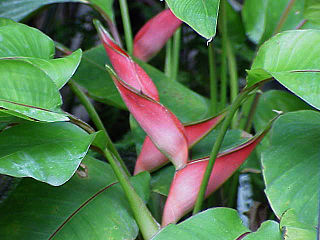
Heliconia stricta is a plant species native to Brazil, Colombia, Venezuela, Ecuador, Peru, Bolivia, Guyana, Suriname, reproducing by seeds and by underground rhizomes. It is reportedly naturalized in Cuba and Puerto Rico, and cultivated as an ornamental in many other warm regions. The young leaves and bracts retain water, forming pools called phytotelmata, which provide habitat for diverse invertebrates.

The St. George Village Botanical Garden is a botanical garden with arboretum located at 127 Estate St. George, Frederiksted, Saint Croix, U.S. Virgin Islands. It is open daily except Christmas; an admission fee is charged.

Alstroemeria psittacina, with the common names Peruvian lily, parrot flower, parrot lily, lily of the Incas, princess lily and New Zealand Christmas bell. It is found in cerrado and pantanal vegetation in Brazil and Argentina.

The San Juan Botanical Garden, officially known as the Botanical Garden of the University of Puerto Rico, is located in the Caribbean city of San Juan, capital of Puerto Rico. This lush 300-acre (1.2 km2) “urban garden” of native and exotic flora serves as a laboratory for the study, conservation and enrichment of plants, trees, flowers, grasses and many other plants. Seventy-five acres are landscaped and open to the general public as well as researchers.

The hook-billed hermit is a threatened species of hummingbird in the family Trochilidae. It is endemic to a small area of Brazil.
The name is derived from the Greek word Ἑλικώνιος (helikṓnios) meaning Lobster Claws, another word for Heliconias. The second part is from the Latin word Excelsa, sometimes meaning tall, probably meaning "tall Lobster Claw" all together. Heliconia excelsa is a species of plant in the family Heliconiaceae. It is endemic to Ecuador. Its natural habitat is subtropical or tropical moist lowland forest. At its maturity, it can reach a height of 8' to 12' or 15' in full sun to half shade.Heliconia excelsa, commonly known as the giant heliconia or hanging lobster claw, is a species of flowering plant in the family Heliconiaceae. It is native to the rainforests of Central and South America, including countries like Costa Rica, Panama, Colombia, and Ecuador.
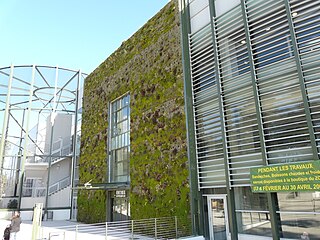
The Montpellier Zoological Park is a French zoological park located in the region Occitanie, in the north of the city of Montpellier.

Heliconia psittacorum is a perennial herb native to the Caribbean and South America. It is considered native to French Guiana, Guyana, Suriname, Venezuela, Colombia, Bolivia, Brazil, Paraguay, Panama and Trinidad and Tobago. It is reportedly naturalized in Gambia, Thailand, Puerto Rico, Hispaniola, Jamaica and the Lesser Antilles. It is often cultivated as a tropical ornamental plant in regions outside its native range.

Strelitzia alba also known as white-flowered wild banana, or Cape wild banana is a plant of the Bird of Paradise family and is endemic to the Garden Route along the southernmost coastal regions of the district of Humansdorp Eastern and district of Knysna in Western Cape in South Africa. It grows in evergreen forest, gorges, and on slopes along the rivers.










